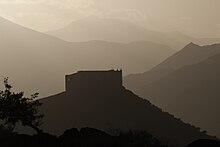Goundafa
The Goundafa are a Berber tribe who controlled large areas in southwestern Morocco in the late 19th and early 20th centuries .
history
Probably coming from the western Anti-Atlas , parts of the tribe moved to the Nfiss Valley on the west side of the Toubkal massif in the 19th century . Here, through the control of the Tizi n'Test passport, they achieved a high degree of economic and political independence from both the central power of the Sultan and from the Glaoua clan, which played the most important role in the south and south-east of Morocco. It was not until 1875 that their then chief, Si Ahmed n'Aït Lhassen, nominally submitted to Sultan Mulai al-Hassan I , who had ruled since 1873 ; in fact, however, the tribe in the region remained largely self-sufficient. After the death of Si Ahmed (1885), his son Si Tayyeb extended the Goundafa's areas of influence over parts of the very fertile Souss plain to the southwest . At the beginning of the protectorate period (1912) he was given the title of "Pascha von Tiznit " by the French and thus control over the entire Souss.
During the years of their dominance, the Goundafa built several fortresses ( kasbahs ) located on heights in the Nfiss Valley and above the Souss plain , including the Agadir n'Gouf near Ijoukak and the Kasbah of Tagoundaft (photos → web links).
literature
- Samuel Pickens, Michel Renaudeau, Xavier Richer: Le Sud marocain. ACR Éditions, Paris 1993, ISBN 2-86770-056-6
